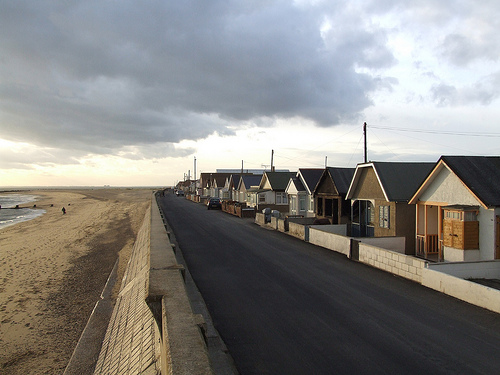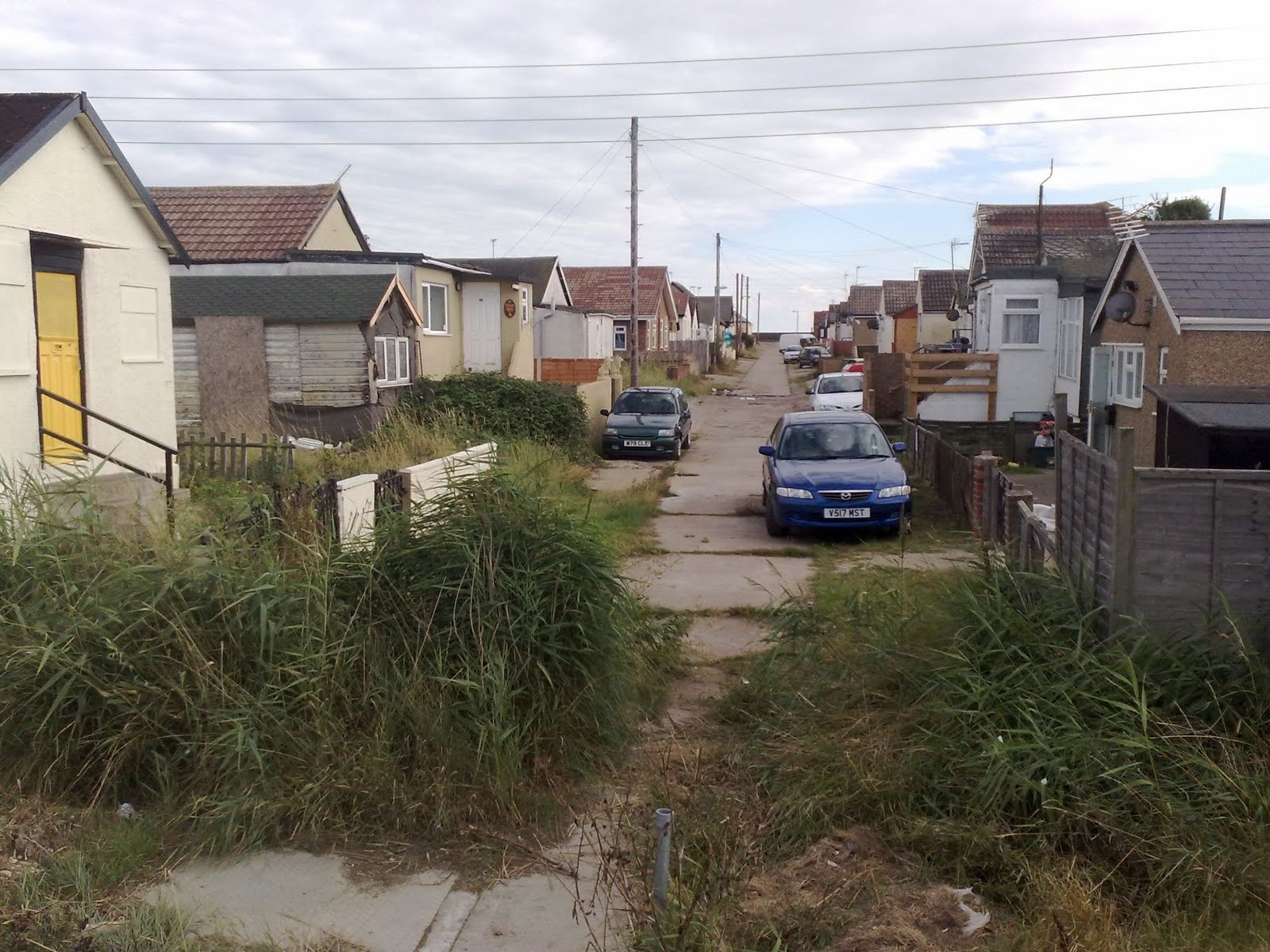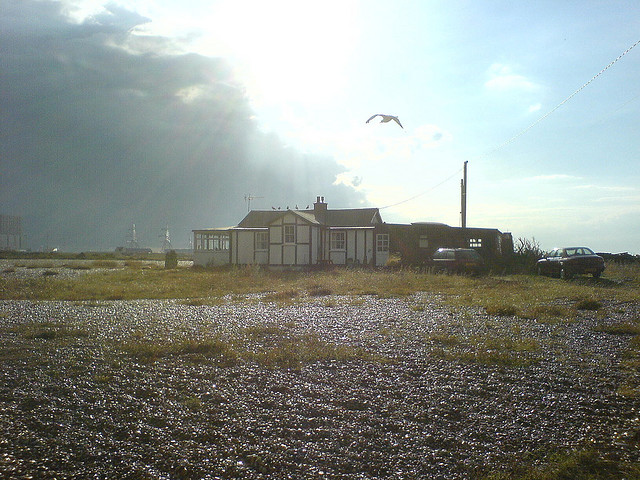Plotlands began in the 1870’s as a way for speculators to offload marginal farmland as Britain’s agrarian populace uprooted en masse to the big cities. Whether barren or dangerously flood prone, worthless land was portioned up and sold off square by square; mostly to the naive and newly mobile working classes of London. Originally the idea was that the crudely constructed sheds that soon appeared on the plots would be occasional weekend retreats, but many londoners quickly came to appreciate the cleaner air and community that the plotlands offered, and as is the Englishman’s wont, they began to extend and improve their dwellings. The popularity of these districts increased after demobilisation in 1918 and with the advent of the motor car, continued to burgeon all the way up to 1939 and the start of the Second World War.
There was another massive surge in plotland expansion by bombed-out city dwellers directly after the war, mainly taking place on decomissioned military camps. But the remnants of the quasi martial law of the Home Front and the massive new powers given to planning authorities by the 1947 Town and Country Planning Act soon put an end to this kind of wild west homesteading. The new town of Basildon was hastily designated in 1949, in order to pave over the anarchic spread of Pitsea and Laindon, where by the end of the war there was a settled population of about 25,000, with no sewerage system, no proper water supply and very little in the way of control. The government and richer neighbours have always worked hard to have these strange British shanty towns removed. The urban poor are viewed with distrust and accused of the crime of bad taste when they try to stake their own claims to a little slice of the good life.
Whilst the majority of these towns were dismantled as hastily as they were thrown up, some have clung to the margins for decades. Plotland areas I know of are Canvey Island, Basildon, Herne Bay, Shepperton, Dungeness and Jaywick, next to genteel Frinton-on-Sea in Essex. Only Jaywick and Dungeness have any numbers of remaining original houses. Dungeness has a somewhat elevated artsy reputation since starring as the post-apocalyptic backdrop to Derek Jarman’s films, whilst Jaywick has to make do with the annual honour of being named the most deprived place in England.
Plotlands are a rare manifestation of unfettered working class creative expression. Outsider architecture, their random chaos is the very anthesis of the controlled and manicured English landscape. Starting with basic materials and plenty of ingenuity, a plotland house can grow into an amalgam of just about any architectural style imaginable. Pebbledash meets pirate ship, via gnomes, palm trees and corinthian columns. The remaining plotlands are insular places that many people don’t visit or even know about. Whilst there is an intense community spirit, there are often problems with crime, poverty and delapidation. But people on the plotlands hold on, adding quirky personal touches to their shacks, handing them down to their children and grandchildren, who now have to contend with living in hastily thrown together buildings that were never meant to last more than a few years, let alone 80.














Lovely bleak stuff. The ideal soundtrack here would be Morrissey adapting Springsteen’s ‘Badlands’… Plotlands, wo-ah-ho-ho-ho-ah-wo-ah-ho…
yep, there’s something very Nebraskan about the plotlands – I’ve always thought that Richard Hawley would provide a good soundtrack too
Interesting, Worm. I don’t think I knew about this.
This one is more cheerful though. I was wondering where all the people were.
thanks Ian, thats a great pic that shows the place in it’s heyday!
Here’s a collection of photos of weird and wonderful plotland houses
Great piece. And pix too. One expects to see a suited J. Meades popping up from behind a breakwater, primed to launch an erudite analysis.
Dungeness is, or was when last I visited c.2000, quite wonderful. The stony beach, the odd bits of discarded (fishing? wartime?) equipment, the wooden housing (including Jarman’s own, which now attracts its steady stream of pilgrims), the miniature railway, the remarkably good fish smokery (another wooden hut) and in the background the power station throbbing away.
And has anyone else noticed the stretch of what is I assume north Kent that you see to the right of the France-wards Eurostar? Bleak, bleak, bleak. I always want to jump out and explore.
I suppose a posher version of these would be the static caravan parks that one can sometimes find in odd places. There should be a low-rent but otherwise standard-issue Ballard novel set amongst them.
You’re right jonathon, it’s very j.meades- one can almost picture the close up of a spinning plastic windmill and a gurning gnome… That whole area of north Kent (Ebbsfleet?) is very bleak indeed! You have to wonder though, at what point does one man’s Jaywick become another man’s Whitstable?
Gaw- a seriously weird example of ‘standard’ mobile homes can be found at Leysdown on the isle of sheppey, what seems like mile after mile of strange bunker-esque caravans
Strange to find these little worlds within worlds even in tiny Britain. The (exploitative or sympathetic?) programme ‘My Big Fat Gypsy Wedding’ was startling in that it revealed this whole morally discrete tribe within our midst.
Terrific post. I have seen the houses at Dungeness, but knew nothing of their history.
Great post – I didn’t know much of this. Made me think of that film Fishtank – looked like it was set in [on?] plotlands.
I have never seen Fishtank Jon, but it looks like my kind of film – a brief search on Imdb says that it was shot in various places along the estuary, including at the wonderfully bleak, and excellently named Mucking Flats at stanford le hope.
I think, if memory serves, that there’s a big section on army base squatters in David Kynaston’s ‘Austerity Britain’
Fishtank’s bleak, but well worth a look. Bit like plotlands, I spose…
Yes, curiously Nebraskan and strangely beautiful in a desolate, windswept sort of way. Lovely post, Worm.
Strange sort of UK prototype for a Favela city.
A great post. These places are very atmospheric and this is very much to do with their rather unusual history. I’ve come rather late to this post, but my travels today took me past some Worcestershire plotlands, the very ones that Jonathan Meades extolled in his Severn Heaven film. I hope to do an English Buildings post about them shortly and will link back to Worm’s post when I do.
Fascinating stuff, Worm. Am I right in thinking that the social displacements caused by Depression and two World Wars are a scarcely known piece of history in this country? For example, I thought I knew a fair bit about the New Forest, having lived in those parts for some years and read up on the local history, but I was staggered to read the other day (in Philip Hoare’s generally staggering book England’s Lost Eden) that from 1918 until the early 1950s there were up to a thousand people living wild in the woods. It seems that an already high population of Gypsies and vagrants was swelled by successive waves of demobbed servicemen, people made jobless and homeless by the Depression, and families fleeing the bombing of Southampton and the other south-coast towns. From the 1920s the newly established Forestry Commission did its best to tidy away the wood-dwellers into a series of compounds — sad little shanty towns of canvas and corrugated iron. These were still there in 1949 when Picture Post ran an indignant article (pics by Bert Hardy, apparently): “In the New Forest, tucked away from the bird-watcher and the week-ending stockbroker, hundreds of poor folk live under stone-age conditions …” The camps were not closed until the 1950s, when their inhabitants seem to have been resettled, more or less forcibly, in the new council estates.